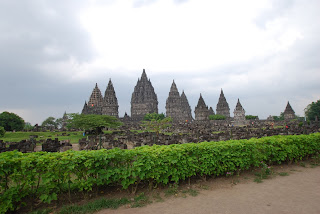November 8th
Yogyakarta Java is a normal city of over 600,000 people, which happens to be located between two of the most visited temple sites in Indonesia. Tours to the sites, as well as, surrounding volcanos are often organized from this hub. Directly south of the train station the warren of narrow alleys has developed into the classic backpacker ghetto, with bars, restaurants and budget accommodations.
Borobudur
UNESCO link
This huge temple is comprised of six square levels with 1500 carved pannels of Buddist teachings, topped with three circular levels punctuated with 72 lattice (bell shaped) stupas, each containing a seated Buddha figure. The temple was built around 780 AD, and fell into obscurity after the fall of the Majapahit Kingdom in the early 1400's and the subsequent growth of Islam in Java. The site was "discovered" in 1814 when the British Empire temporarily wrestled control of Java from the Dutch. The surround jungle was cleared and the site was surveyed in the 1870's. The temple has undergone two more reconstructions one in 1911 and one in from 1968 to 1983. The current site is surrounded by well manicured landscaping and the back drop is lush tropical hills.
There is a simple museum and an exit that mazes through the souvener stalls.
Prambanan
UNESCO link
This large complex of Hindu temples dates to roughly 800 AD and lies only 60 km from Borobudur. This means the two significant temple sites were being constructed and used in aproxamately the same era by different religious sects.




In Prambanan's primary temple grouping the center temple to Siva is 47.6 meters tall, while the temples to Brama and Vishnu are 33 meters tall. Surrounding these temples are some shorter temples that have bee restored. In the outter yard are the remains of some 240 little temples that have not been restored yet.
We unfortunately did not get to see much of the site other than the main complex because the weather changed to a thunder storm. We took refuge in the small museum for at least an hour.
Yogyakarta Java is a normal city of over 600,000 people, which happens to be located between two of the most visited temple sites in Indonesia. Tours to the sites, as well as, surrounding volcanos are often organized from this hub. Directly south of the train station the warren of narrow alleys has developed into the classic backpacker ghetto, with bars, restaurants and budget accommodations.
Borobudur
UNESCO link
This huge temple is comprised of six square levels with 1500 carved pannels of Buddist teachings, topped with three circular levels punctuated with 72 lattice (bell shaped) stupas, each containing a seated Buddha figure. The temple was built around 780 AD, and fell into obscurity after the fall of the Majapahit Kingdom in the early 1400's and the subsequent growth of Islam in Java. The site was "discovered" in 1814 when the British Empire temporarily wrestled control of Java from the Dutch. The surround jungle was cleared and the site was surveyed in the 1870's. The temple has undergone two more reconstructions one in 1911 and one in from 1968 to 1983. The current site is surrounded by well manicured landscaping and the back drop is lush tropical hills.
There is a simple museum and an exit that mazes through the souvener stalls.
Prambanan
UNESCO link




In Prambanan's primary temple grouping the center temple to Siva is 47.6 meters tall, while the temples to Brama and Vishnu are 33 meters tall. Surrounding these temples are some shorter temples that have bee restored. In the outter yard are the remains of some 240 little temples that have not been restored yet.
We unfortunately did not get to see much of the site other than the main complex because the weather changed to a thunder storm. We took refuge in the small museum for at least an hour.












2 comments:
This is awesome Kari
So interesting. Wish I were there.
Post a Comment